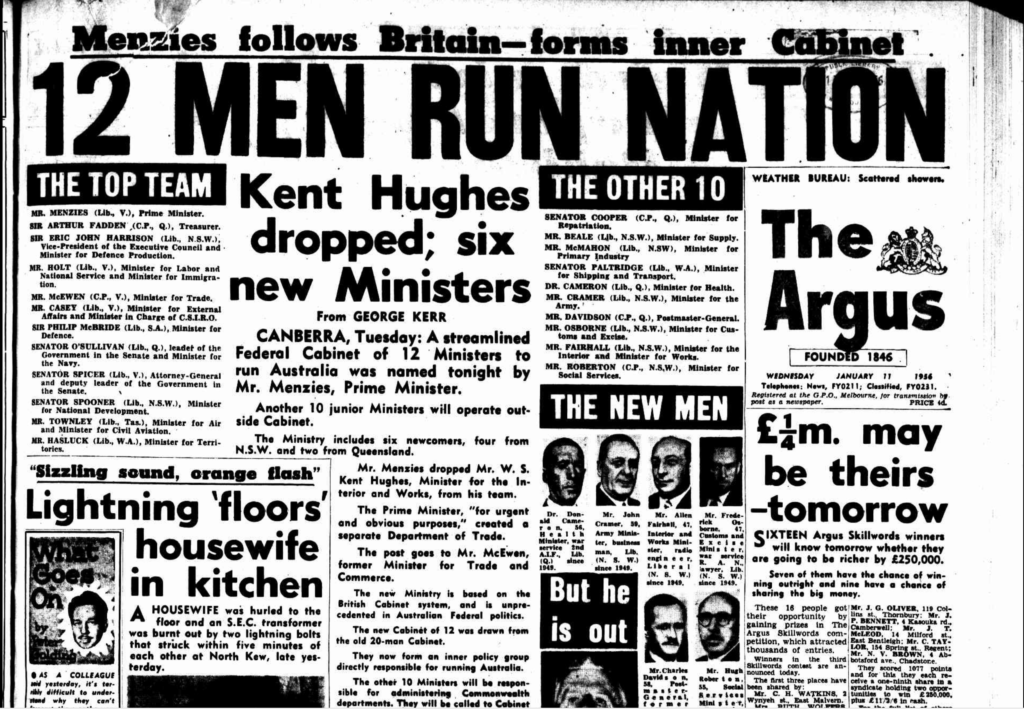On this day, 10 January 1956, an important step in the evolution of Australia’s governing system is taken when Robert Menzies announces that his new Ministry will feature an ‘Inner Cabinet’ and an ‘Outer Ministry’, otherwise known as the ‘Senior’ and ‘Junior’ Ministries. The latter would only attend Cabinet meetings which discussed matters directly related to their portfolio, thus helping to ensure that the Cabinet system remained efficient and authoritative, even with a record 22 Ministers (12 of which were to remain full Cabinet members). Menzies was borrowing the new practice from British precedent, his own experiences as a wartime leader, and the suggestion of Allen Brown, the Secretary of the Prime Minister’s Department.
When the Australian Commonwealth was first inaugurated in 1901, the original Barton Cabinet featured 11 Ministers – a number which reflected the fact that a federal system left a very large number of responsibilities to the states. However, over the years the size of the Ministry inevitably grew as new federal departments were created and the Commonwealth began involving itself in new areas which were often unforeseen by the Constitution’s framers. These size increases gradually made the Cabinet more unwieldy, and produced a stratification which undermined the principle that the Prime Minister was merely the first among equals.
The 1956 ministerial expansion was due to the fact that Menzies had created three new Ministries of Trade, Primary Production, and Customs and Excise, splitting up responsibilities that had previously been intertwined as the global economic landscape which Australia had to navigate became ever more complex. As the term ‘Junior Ministry’ implied, the expansion also gave Menzies the chance to give younger talented MPs the opportunity to gain ministerial experience, and thus revitalise and strengthen his government.
While this was a novel and significant change, it is worth noting that Menzies had already informally been using a tiered system for Cabinet meetings since 1954, though in that case an attempt to divide ministers into those responsible for ‘policy’ and those for ‘administration’ had proven largely unworkable. Moreover, the practice of having a smaller and more powerful group within Cabinet to facilitate decision making could be traced back to 1938, when Prime Minister Joseph Lyons reorganised Cabinet to form an ‘inner group’ of Ministers to examine and formulate policy prior to submission to the full Cabinet.
During World War Two, Menzies had instituted a select War Cabinet which often directed much policy with little reference to the full Ministry, as well as an innovative and streamlined ‘Economic Cabinet’. When Labor obtained power in late 1941 it kept the War Cabinet system as a necessary wartime efficiency, but when the war concluded they abandoned the practice which ran against Labor’s conception of Ministerial equality (indeed, it is worth noting that a key difference between Labor and the Coalition is that the ALP caucus elects Ministers, whereas a Liberal leader is free to choose their own, hence Labor Ministers have an authority and standing which is separate to their PM).
This philosophical difference would be seen in 1956, when Menzies’s change was not treated as an uncontentious administrative decision, but instead denounced by the Leader of the Opposition H.V. Evatt. Evatt believed that the new system would create ‘confusion, misunderstanding and inefficiency’, whilst also cutting off the Outer Ministers from ‘vital Cabinet administrative activities’. The latter point was most significant when it came to Ministers who had effectively been demoted to sit outside of Cabinet, notably including the Minister for Social Services Billy McMahon.
This ALP resentment at the tiered system would survive another 16 years, such that when Labor finally returned to the Ministerial benches in 1972, Gough Whitlam followed a caucus decision that every one of his Ministers would be a member of Cabinet – even with them numbering a whopping 27 after the short-lived ‘two-man ministry’/‘duumvirate’. However, the Whitlam Government was not noted for its administrative stability, and not only would Malcolm Fraser restore Menzies’s approach, but his Labor successor Bob Hawke would maintain it. It has since endured to the present day.
Further Reading:
Cabinet – Parliament of Australia (aph.gov.au)
A.W. Martin, Robert Menzies: A Life Volume 2 1944-1978 (Melbourne University Press, 1999).
Sign up to our newsletter
Sign up for our monthly newsletter to hear the latest news and receive information about upcoming events.


